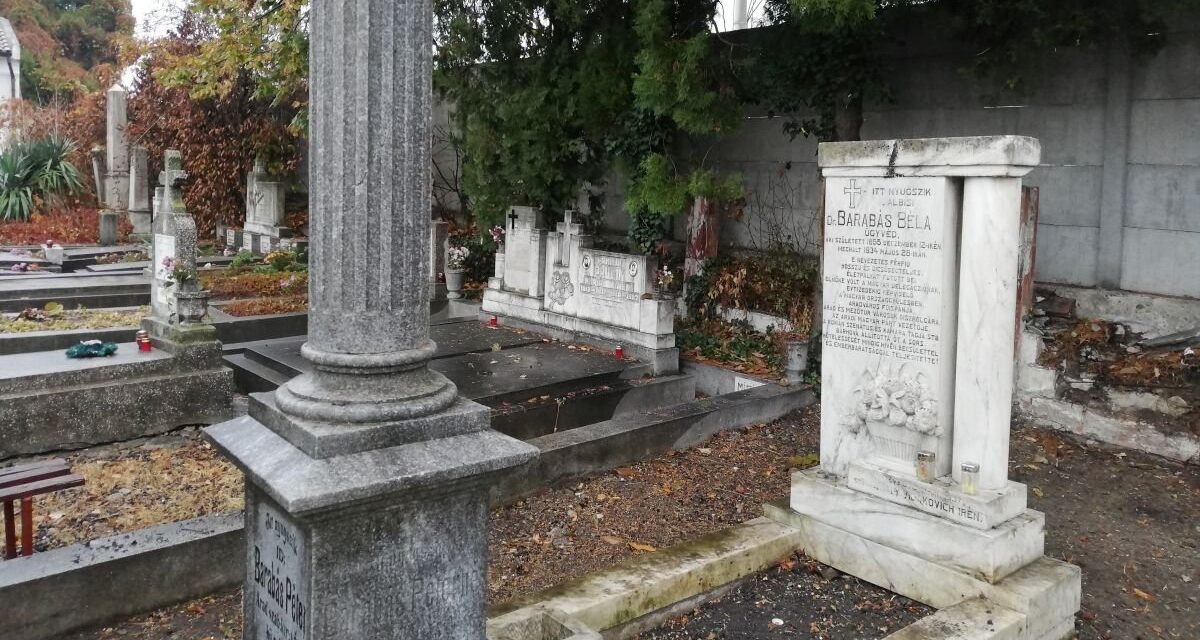Those who were not left alone when they were dead: "Here the cemetery stands as a witness, / The word is still in Hungarian on their heads..."
Arad cemeteries hide and have hidden the bones of prominent Hungarian public figures, generals of the army in 1848, celebrated actors of the beginning of the 20th century, and soldiers who died in the Second World War.
In the case of some, the past tense is used because the peace decree that ended the First World War and the nationalist-communist dictatorship that followed the Second World War not only persecuted the living because of their nationality, but also harassed the dead.
The history of the Arad cemeteries and the graves of the famous personalities who rest in them were researched and mapped for several decades by local historian and journalist János Ujj, a retired history teacher, who compiled the results of his work into a volume. His book Walks in Arad Cemeteries and Memorials was published in 2009 by the Alma Mater Foundation. There are twelve public cemeteries in Arad, and according to the author, each of them had or has four or five graves that make the grave gardens famous.
"I don't know if I was more than six years old when my grandmother and I placed flowers on the graves of Hungarian heroes in the Lower Cemetery in Arad on All Saints' Day. When I was already an adult, in the 1980s, those certain hundred or so graves were exterminated, but by turning the bones onto the road with a bulldozer.
It was shocking for anyone who went there to see: skulls, leg bones, everything was thrown away, loaded onto trucks and transported away. And then I decided that if they treat ours like this, then let's see who among our Hungarian ancestors is buried here."
- the local historian recalled what gave him the determination to do the research. He collected the material from which the book was compiled for twenty to twenty-five years. "Gyula Salacz was the mayor of Arad for 26 years between 1875 and 1901, the theater, the town hall, all the big schools, banks were built during his time... He died in 1915, and in 2000 it was not known where his grave was and it's impossible to know to this day," János Ujj expressed how ungrateful posterity was towards the former mayor.
The graves of all the famous actors of the Arad theater who died also suffered a similar fate. A Hungarian theater operated in Arad until 1948, and even had the status of a national theater from 1902 to 1919.
"Ódry Lehel - the father of Árpád Ódry, the celebrated actor of the 1920s and 30s - was an opera singer, he also opened a singing school in Arad, he died here in 1920, but we have no idea where he was buried. István Szöllősi was the secretary of the Kölcsey Association for thirty-odd years, a distinguished teacher in Arad, he corresponded with half the world, he was the uncle of Pista for all of Transylvania, and his grave disappeared when the concrete slab was removed and a completely unknown person was buried in its place in 2008- in"
János Ujj continued the line. According to the local historian, the Upper Cemetery was the elegant cemetery of Arad, because famous personalities had been buried there since 1873, but the trees in front of the crypt row were cut down, and then a protective barrier was placed between the Hungarian graves and the visitors.
People from the majority nationality could be buried there, so first the graves were covered up, and then when these places were sold, the old inscriptions were removed from all the monuments," he said about the Hungarian graves.
János Ujj recalled that in the 1990s, when Levente Bognár was appointed vice-prefect at the suggestion of the RMDSZ (later he was also deputy mayor of the city for twenty years), 26 graves were marked in the Upper Cemetery together with the warden, which, so to speak, should be "left alone".
“Four months passed and I was shocked to find that someone had been buried on one of them. He became a new caretaker, but maybe the old one didn't consider what the sub-prefect, the local representative of the government, said to be binding on him either" -
János Ujj perceived the situation.
The tomb of "the greatest Hungarian", Béla Barabás, was saved recently. In 2018, on a civil initiative, RMDSZ paid the rent for the grave of the former Member of Parliament for another seven years to the municipal company that maintains public cemeteries, so the danger of being buried on it was averted. The grave monument - together with the grave of the parliament member's father, Péter Barabás - was renovated free of charge by gravestone carver Gábor Szűcs. Béla Barabás was born in Arad on December 12, 1855, and died here on May 28, 1934.
The lawyer-educated politician was the mayor of Arad county, and was elected five times as a member of the Parliament of Pest. After the annexation of Transylvania to the Kingdom of Romania, he decided to stay and quickly became one of the leading figures in minority Hungarian political life. From 1926, he was also a senator of the Bucharest parliament. He carried out significant journalistic activities in national and local newspapers. For a while he was the editor of the Arad és Vidéke , and the editor-in-chief of the Arad Magyar Újság.
His father, Péter Barabás, was the master carpenter who erected the 13-branched mulberry tree cut from his garden at the site of the execution of the generals who were shot dead and hanged on October 6, 1849, and this was the first memorial erected in honor of the freedom fighters who fell victim to the reprisals.
The former military cemetery was liquidated, and the Tisztviselőtelep district is located in its place. General János Lenkey, who was considered one of the Arad martyrs, was buried there. He was sentenced to death, but was ultimately not executed because of his overwhelming mental illness; He died in February 1850 in the castle prison in Arad.
"The grave of János Lenkey was the last in this cemetery, as the remains of the other dead were transferred to another public cemetery in Arad, but Lenkey's was still there in the 1920s and 30s. In 1936, a delegation from the city of Eger came to Arad, and after several weeks of negotiations, they exhumed his remains and took them home to his hometown, Eger.
- explained local historian and journalist Péter Puskel.
In 2021, the crypt front of Károly Vécsey, one of the 13 generals executed in Arad on October 6, 1849, was re-inaugurated in the Arad County Museum. The epitaph containing the epitaph was placed in the Palace of Culture, which houses the museum, in 1912, but it could not be viewed for long, because Arad came to Romania as a result of the border changes following the First World War, and the new power gradually tried to erase Hungarian-related memorials from public memory. It is no longer known when, but the crypt facade was covered with a cupboard and was only discovered decades later, in the spring of 2019, during a major cleaning. The re-inauguration following the restoration was held as part of an exhibition, where some of Vécsey's personal belongings could be viewed, such as the crucifix he held in his hand before his execution, or the farewell letter he wrote to his wife on his last night.
“It was written in German, of course, and we noticed that researchers always adopted the same translation. We thought we would have it translated again, but it was not so easy, because it turned out that it was written in a very rare font, which has not been used in Germany since the 1930s. With the help of emigrant Aradians, we found an old lady living in Cologne who knew the font and transcribed the letter. There are no sensational changes compared to the previous translation, but there are shifts in emphasis. Vécsey was the last one to be executed, this indicates that the Habsburg court considered him the most dangerous freedom fighter leader, which is why it is important to us"
- said Károly Fekete, vice president of the Kölcsey Association. The 13 generals who fell victim to the bloody reprisals of the Hungarian Revolution and War of Independence in 1848-1849 were not granted eternal rest even after their execution. Their remains were moved several times. The ashes of the revolutionary armies were finally placed in 1974, on the 125th anniversary of the execution, in the pedestal of the obelisk standing at the supposed place of loss. But only 11 generals are buried in Arad: the grave of Ernő Kiss is located in Elemér in the southern region, and that of Dessewffy Arisztíde in Margonya in the highlands.
Even in the 21st century, the "oldest hussar" had no rest. Based on a Romanian-Slovak intergovernmental agreement, in the spring of 2013, the remains of the late László Skultéty were exhumed in the Újarad cemetery and reburied in his birthplace, Hegyesmajtény in the Uplands. He retired after 81 years of service, he inspired the figure of János Háry in János Garay's work The Obsitos Vítez. The exhumation took place without consulting the local Hungarian community, or more precisely, the representatives of the Hungarians were presented with ready-made facts. According to János Ujj, cultural and historical damage has been done to Arad.
"The city was not born big, but buried. Born in 1735 near Trencsén, he joined the army at the age of 15 and was discharged at the age of 96 when the Coburg regiment was stationed in Arad in 1831. It is said that he could not get on his horse, so he stayed here and spent a few months living his life as an obsitos in Arad"
explained János Ujj.
In the cemeteries in and around Arad, many Hungarian veterans who died during the retreat in the fall of 1944, during the Second World War, are buried in the battles fought with the Soviet and Romanian troops. In addition to them, somewhere in the Alsótemete may be the ten victims who were convicted and executed in 1958 during the show trials in Romania following the Hungarian revolution of 1956, the so-called Szoboszlay trial. In 2018, excavations were also carried out in the cemetery, but they were not found, so their relatives could not give them the last rites until today.
According to János Ujj, commemoration is important because the dwindling Hungarian community needs to be made aware of the outstanding personalities who contributed to the rise of the city and the region in the past. "Here the cemetery stands as a witness, / The word Hungarian is still on his head..." If Sándor Reményik wrote this in the 1930s, then after 2000 it will apply to Arad and to all cities in Transylvania where Hungarians live in scattered places," said János Ujj.
Featured image: "The greatest Hungarian", the graves of Béla Barabás and his father Péter Barabás escaped as a result of community cooperation • Photo: Zsolt Lehel Pataky













